Catholic Customs
 |
 |
 |
 |
 |
 |
 |
Rogation Day Processions, Prayers & Perambulations
The feast of the Ascension is the day that marks Our Risen Lord's entering into His triumph and the zenith of His glory as King, Redeemer and Victor. A feast filled with such glory is rightly preceded by acts of penance and supplication, because supplications made during Our Lord's last days on Earth bring the most graces.
The feast of the Ascension is preceded by the three Minor Rogation Days (Monday, Tuesday, and Wednesday) which the Church set aside, along with the Major Rogation Day of April 25th, for processions to appease God's anger for the sins of men, to ask for blessings on the fields, and to implore protection from natural disasters such as hailstorms, floods, and droughts. The name comes from the Latin rogare (to pray, beseech).
The more ancient Major Rogation originated at a very early date in order to counteract the Roman Robigalia processions that the pagans made in honor of their gods. (1) St. Gregory the Great (d. 604) regulated this custom by arranging the Litany of Saints, making it the standard litany for processions in the Latin Church and naming April 25 as the solemn day to process and chant this litany.
The Minor Rogation Days originated around the year 458 when a series of terrible calamities was ravaging Vienna. Earthquakes shook the land destroying fields and farmlands, wild beasts roamed the countryside entering the market places of the cities, and fires ravaged the land.
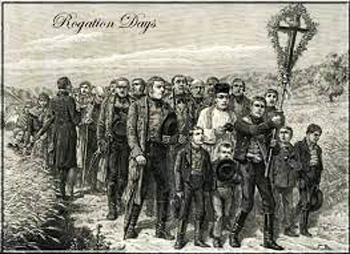
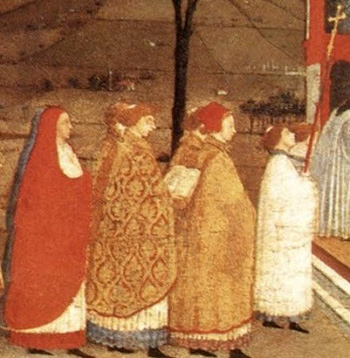 Understanding that such calamities were a punishment from God, St. Mamertus, Bishop of Vienna, ordered that on the Ascension Day or the three days preceding it, prayers of supplication be said by the people begging for God's mercy and asking for a blessing on the crops and fields.
Understanding that such calamities were a punishment from God, St. Mamertus, Bishop of Vienna, ordered that on the Ascension Day or the three days preceding it, prayers of supplication be said by the people begging for God's mercy and asking for a blessing on the crops and fields.
This custom spread to the rest of Gaul; in 511 the First Council of Orleans appointed the three days preceding the Ascension as Rogation Days in which the faithful were obliged to fast and abstain from flesh meat and to take part in the solemn processions of the Church. Masters were even obliged to exempt their slaves or servants from work so that they could take part in the ceremonies of the Church.
The Minor Rogation Days were extended to the whole Church under Pope Leo III (795-816) who omitted the obligation for fasting that was observed in the beginning, while maintaining that of abstinence. (2) Soon the Rogation processions spread throughout all of Europe, even reaching England through St. Augustine of Canterbury before the papal institution.
Catholics of old, understanding how intricately united were the prayers of the faithful with the success of the harvest, held these days with great reverence. They did not take the fruits of the Earth and gifts of God's creation for granted. Every field, well, spring, river, and forest was held as sacred, because they were created by God and were sources of life for men. Catholics also understood that while God permits disasters, the devils are often the agents who destroy the land. Through the power given by Christ to the Church, the processions helped to drive out demons.
The Golden Legend explains:
"We carry the cross and ring the bells that the demons may flee in terror; for as the king in the midst of his army has royal ensigns, namely the trumpets and banners, so Christ the eternal King in the midst of His Church Militant has bells for trumpets, and the cross for a banner.
"And as a tyrant is much affrighted at hearing in his land the trumpets of a powerful enemy king and seeing his banners, so also the demons who dwell in the dark are stricken with fear when they hear the trumpets of Christ, namely the bells, and see His banner, the cross." (3)
Poor and wealthy, commoner and noble alike obeyed the summons of the Church. In the early morning hours, all assembled in the church to receive ashes on their foreheads and be blessed with holy water before beginning the penitential exercises.
In cities, smaller parishes joined together to form one large procession that was led by the processional cross of the principal church. The bare-footed faithful followed that standard singing the antiphons and litanies. The cross, raised aloft high in the air, was a symbol of Our Risen Lord ascending to Heaven, and the faithful following it represented the Saints of the Old Law who accompanied Our Lord in His Ascension.
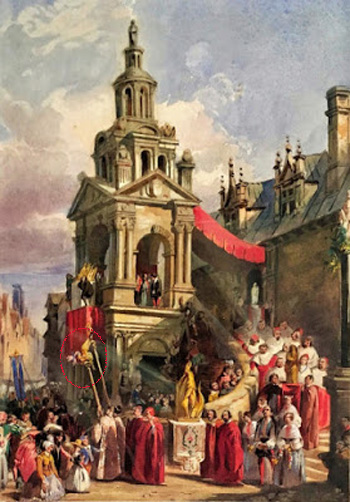
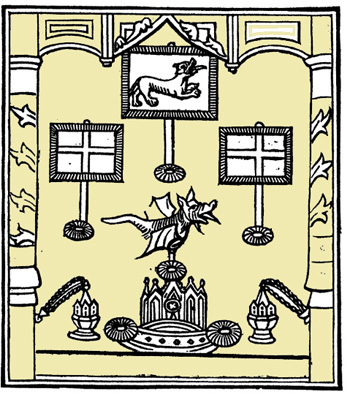 Even Kings and Queens cast off their royal diadems to don coarse garments and walk barefoot with the rest of the faithful behind this glorious standard. (4) So cherished was the unity that these processions inspired that men reconciled conflicts and buried resentments against their neighbors during these holy days.
Even Kings and Queens cast off their royal diadems to don coarse garments and walk barefoot with the rest of the faithful behind this glorious standard. (4) So cherished was the unity that these processions inspired that men reconciled conflicts and buried resentments against their neighbors during these holy days.
Led by the cross, banners and relics, the faithful processed through every city street, meadow, field and farmyard, and the clergy blessed the land as they went. The clergy also blessed every stream, well, spring and pond along the way so that these sources of cleansing and life-giving water would always flow in abundance. In fishing villages, the sea and fishing boats were also blessed and the priests implored God's protection for those who go to sea where the mighty waters surge and swell.
The victory of Our Lord was represented in a peculiar fashion in the church processions of Gaul and southern England. In these churches, a dragon with a straw-stuffed tail was carried before the cross on the first two days of the Rogation processions to signify the Devil's reign before and during the Old Law.
On the third day, the straw was removed from the dragon's tail so that the tail hung down dragging on the ground; then the dragon went behind the cross to demonstrate the Devil's defeat. (5)
In some areas before this last procession ended, the parishioners beat, kicked, stoned and tore the dragon to pieces. What a glorious tribute to the victory of Our Risen Lord over the terrible Fiend!
At the conclusion of the procession on each day, the Holy Sacrifice of the Mass was offered in the appointed stational church or the church where the procession began to complete the reconciliation between God and His guilty children.
The perambulations - confirming the boundaries
After the fields were blessed, it was the custom in many English villagers for the processions to perambulate the boundaries of the parish on one or all of the Rogation days. (6)
During the perambulations, all of the parishioners met to form a procession at the parish church that would traverse the prominent boundary points around the parish. The lord of the manor in country places or the highest member of the clergy in cities led the procession followed by the rest of the clergy bearing crosses and a large banner. Next came the public officials and other prominent parishioners carrying hand-bells, staves and banners who were followed by the rest of the parishioners.
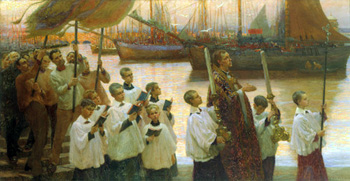 The boundary points were marked by prominent trees, ponds, large rocks, wells and wayside crosses. In some parishes, the procession stopped at one or several boundary trees (usually oaks or elms), and the clergy read the Gospel of the day or a saint legend. The tree was called the "Gospel tree" or "Gospel oak." If the dragon was in the procession, it was removed to a location out of earshot behind a rock or well (called the Dragon's Rock or Dragon's Well) during the prayers and Gospel reading. (7)
The boundary points were marked by prominent trees, ponds, large rocks, wells and wayside crosses. In some parishes, the procession stopped at one or several boundary trees (usually oaks or elms), and the clergy read the Gospel of the day or a saint legend. The tree was called the "Gospel tree" or "Gospel oak." If the dragon was in the procession, it was removed to a location out of earshot behind a rock or well (called the Dragon's Rock or Dragon's Well) during the prayers and Gospel reading. (7)
Walking the boundaries often lasted many hours, because the exact path of the boundary had to be strictly followed, even if it led through houses, streams and canals. The elders of the community dutifully preserved the memory of these boundary points, passing the knowledge on to the youth so that they might faithfully maintain the exact boundaries, rights and privileges.
Until the days when the Church is restored to her glory and the Rogation processions once again wind through every street and field led by the parish priests, let us at least join our prayers with the Church by processing through our fields, gardens and yards praying the Litany of Saints and sprinkling holy water. The head of a household may lead his family along the boundary lines of his property, imploring God's blessing upon his land. In this way, we will share in the graces attached to the Rogation days and regain our Catholic spirit.
To be continued
Posted May 23, 2022
The feast of the Ascension is preceded by the three Minor Rogation Days (Monday, Tuesday, and Wednesday) which the Church set aside, along with the Major Rogation Day of April 25th, for processions to appease God's anger for the sins of men, to ask for blessings on the fields, and to implore protection from natural disasters such as hailstorms, floods, and droughts. The name comes from the Latin rogare (to pray, beseech).
The more ancient Major Rogation originated at a very early date in order to counteract the Roman Robigalia processions that the pagans made in honor of their gods. (1) St. Gregory the Great (d. 604) regulated this custom by arranging the Litany of Saints, making it the standard litany for processions in the Latin Church and naming April 25 as the solemn day to process and chant this litany.
The Minor Rogation Days originated around the year 458 when a series of terrible calamities was ravaging Vienna. Earthquakes shook the land destroying fields and farmlands, wild beasts roamed the countryside entering the market places of the cities, and fires ravaged the land.

‘We carry the cross and ring the bells that the demons may flee in terror’

This custom spread to the rest of Gaul; in 511 the First Council of Orleans appointed the three days preceding the Ascension as Rogation Days in which the faithful were obliged to fast and abstain from flesh meat and to take part in the solemn processions of the Church. Masters were even obliged to exempt their slaves or servants from work so that they could take part in the ceremonies of the Church.
The Minor Rogation Days were extended to the whole Church under Pope Leo III (795-816) who omitted the obligation for fasting that was observed in the beginning, while maintaining that of abstinence. (2) Soon the Rogation processions spread throughout all of Europe, even reaching England through St. Augustine of Canterbury before the papal institution.
Catholics of old, understanding how intricately united were the prayers of the faithful with the success of the harvest, held these days with great reverence. They did not take the fruits of the Earth and gifts of God's creation for granted. Every field, well, spring, river, and forest was held as sacred, because they were created by God and were sources of life for men. Catholics also understood that while God permits disasters, the devils are often the agents who destroy the land. Through the power given by Christ to the Church, the processions helped to drive out demons.
The Golden Legend explains:
"We carry the cross and ring the bells that the demons may flee in terror; for as the king in the midst of his army has royal ensigns, namely the trumpets and banners, so Christ the eternal King in the midst of His Church Militant has bells for trumpets, and the cross for a banner.
"And as a tyrant is much affrighted at hearing in his land the trumpets of a powerful enemy king and seeing his banners, so also the demons who dwell in the dark are stricken with fear when they hear the trumpets of Christ, namely the bells, and see His banner, the cross." (3)
Poor and wealthy, commoner and noble alike obeyed the summons of the Church. In the early morning hours, all assembled in the church to receive ashes on their foreheads and be blessed with holy water before beginning the penitential exercises.
In cities, smaller parishes joined together to form one large procession that was led by the processional cross of the principal church. The bare-footed faithful followed that standard singing the antiphons and litanies. The cross, raised aloft high in the air, was a symbol of Our Risen Lord ascending to Heaven, and the faithful following it represented the Saints of the Old Law who accompanied Our Lord in His Ascension.

The Procession of the Dragon (see dragon in red circle) at Rouen, by C. Boulanger; below, woodcut with symbols: cross, incense, banners, dragon

Led by the cross, banners and relics, the faithful processed through every city street, meadow, field and farmyard, and the clergy blessed the land as they went. The clergy also blessed every stream, well, spring and pond along the way so that these sources of cleansing and life-giving water would always flow in abundance. In fishing villages, the sea and fishing boats were also blessed and the priests implored God's protection for those who go to sea where the mighty waters surge and swell.
The victory of Our Lord was represented in a peculiar fashion in the church processions of Gaul and southern England. In these churches, a dragon with a straw-stuffed tail was carried before the cross on the first two days of the Rogation processions to signify the Devil's reign before and during the Old Law.
On the third day, the straw was removed from the dragon's tail so that the tail hung down dragging on the ground; then the dragon went behind the cross to demonstrate the Devil's defeat. (5)
In some areas before this last procession ended, the parishioners beat, kicked, stoned and tore the dragon to pieces. What a glorious tribute to the victory of Our Risen Lord over the terrible Fiend!
At the conclusion of the procession on each day, the Holy Sacrifice of the Mass was offered in the appointed stational church or the church where the procession began to complete the reconciliation between God and His guilty children.
The perambulations - confirming the boundaries
After the fields were blessed, it was the custom in many English villagers for the processions to perambulate the boundaries of the parish on one or all of the Rogation days. (6)
During the perambulations, all of the parishioners met to form a procession at the parish church that would traverse the prominent boundary points around the parish. The lord of the manor in country places or the highest member of the clergy in cities led the procession followed by the rest of the clergy bearing crosses and a large banner. Next came the public officials and other prominent parishioners carrying hand-bells, staves and banners who were followed by the rest of the parishioners.

Rogation procession by the sea ports in St. Ives, Cornwall
Walking the boundaries often lasted many hours, because the exact path of the boundary had to be strictly followed, even if it led through houses, streams and canals. The elders of the community dutifully preserved the memory of these boundary points, passing the knowledge on to the youth so that they might faithfully maintain the exact boundaries, rights and privileges.
Until the days when the Church is restored to her glory and the Rogation processions once again wind through every street and field led by the parish priests, let us at least join our prayers with the Church by processing through our fields, gardens and yards praying the Litany of Saints and sprinkling holy water. The head of a household may lead his family along the boundary lines of his property, imploring God's blessing upon his land. In this way, we will share in the graces attached to the Rogation days and regain our Catholic spirit.
To be continued
- https://www.newadvent.org/cathen/13110b.htm
- William S. Walsh, Curiosities of Popular Customs and of Rites, Ceremonies, Observances, and Miscellaneous Antiquities (Philadelphia: J. B. Lippincott Company, 1898), p. 841.
- Jacque de Voraigne, The Golden Legend, p. 280
- Dom Prosper Guéranger, The Liturgical Year, vol. IX (Fitzwilliam, New Hampshire, Loreto Publications, 2013) p. 132.
- The Golden Legend, p. 280
- The exact origin of this custom is not known, but it is believed to have been developed shortly after the country was divided into parishes in the 8th century, probably as an extension of the Rogation processions. Steve Roud, The English Year (Penguin Books: 2006), p. 176.
- William S. Walsh, Curiosities of Popular Customs and of Rites, Ceremonies, Observances, and Miscellaneous Antiquities (Philadelphia: J. B. Lippincott Company, 1898), p. 141.
Posted May 23, 2022
______________________
_____________________
 |
 |
 |
 |
 |
 |